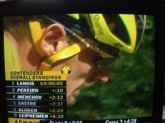If you’re watching the Tour de France every day on OLN — a bad habit in our household driven by the fact it’s the only place to see the race here in America — you’re well acquainted with the astounding caravan that moves along with the race. Motorcycles carrying TV, video and still photographers and course marshalls and timekeepers. Cars carrying race officials. Team cars — at least one for every starting squad of nine riders — carrying the team directors (the overall race strategists) and sundry VIPs and journalists. Neutral cars to support riders up and down the course regardless of which team they’re on. Overhead, at least one helicopter shadowing the progress of the daily race leaders. One of the more demanding and stressful factors for Tour riders must be the constant din of honking cars, revving engines and churning helicopter rotors.
For fans, though, the presence of cameras rolling along with the riders means that you’re right in the middle of the action. For riders, it means there’s no place to hide when something goes wrong. That’s what happened today for Floyd Landis, the former Lance Armstrong lieutenant who had managed to take the race leader’s yellow jersey this year. After a strong finish yesterday on one of the Tour’s classic tough mountain stages, lots of people had started to feel Landis would go on to win the race. But today — today was another brutally hard day, and on the stage’s last climb, Landis blew up. When one of his rivals accelerated sharply and the group around him chased, Landis simply couldn’t make his legs go any faster or harder. It was stunning to see — at least for Tour geeks who are used to seeing a single rider impose his will on the race.
Of course, Landis had one faithful companion as he found himself wallowing up the climb, his closest rivals vanishing up the road ahead of him: as usual, a Tour cameraman was there to capture every moment of suffering. All Landis could do was keep turning over the pedals until he got to the top, no matter how long it took.
[Later: Landis avoided the media at the finish, but later gave what Velonews termed an “impromptu press conference” during which he showed a lot of class. One exchange:
Q: Did you know when you were dropped that the yellow jersey was gone?
FL: I knew I felt very, very bad. I didn’t expect to stay close to the leaders. I did what I could. I kept fighting, but I didn’t have much left. I did everything in my power to stay close, but you saw what happened. ]
Technorati Tags: cycling, tour de france, tv


